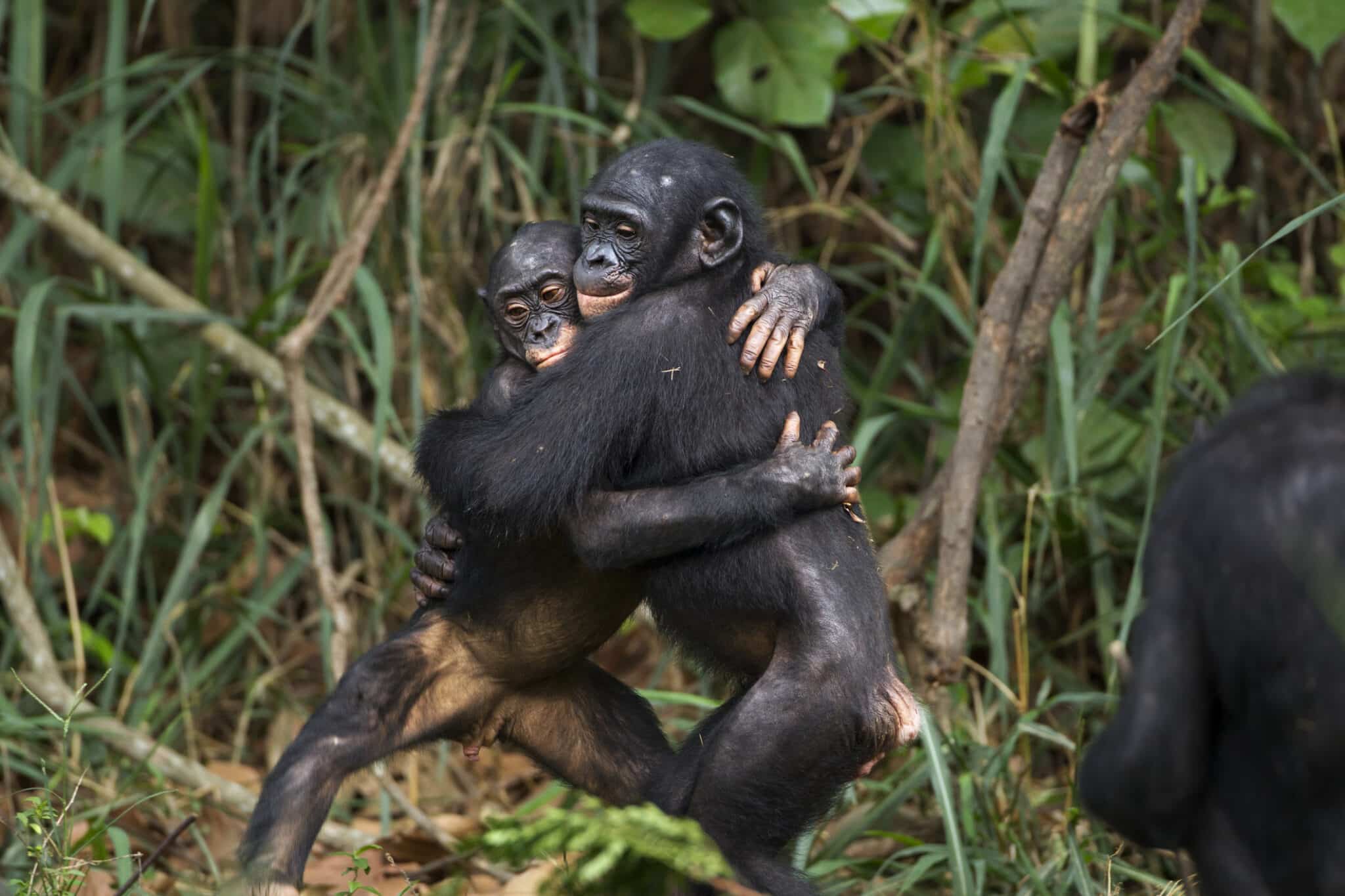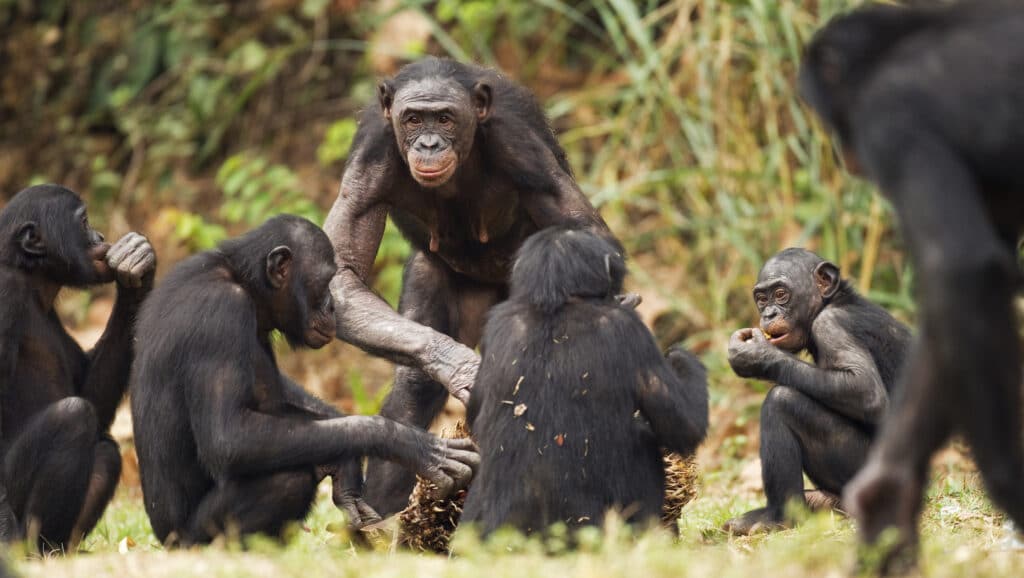Could Tolerant and Peaceful Bonobos Be the Model for Human Peacemaking?

 Why you can trust us
Why you can trust us
Founded in 2005 as an Ohio-based environmental newspaper, EcoWatch is a digital platform dedicated to publishing quality, science-based content on environmental issues, causes, and solutions.
Humans share 98.7 percent of their DNA with two species of endangered great apes: bonobos (Pan paniscus) and chimpanzees (Pan troglodytes). Bonobos — which can only be found in forested regions of the Democratic Republic of Congo (DRC), south of the Congo River — differ from chimpanzees in appearance and behavior. They are usually smaller, and their societal groups are led by females and are generally more peaceful.
It is the bonobos’ peaceful nature and how it relates to the rare ability of humans to show tolerance and cooperate with one another that is the subject of a new study by Harvard primatologists. Bonobos have been dubbed “hippie apes” by researchers due to their harmonious disposition and active sex lives, the Harvard Gazette reported.

Anup Shah/ Stone / Getty Images
Not as much is known about the social relationships of bonobos in comparison with those of chimpanzees due to the remoteness of the bonobos’ habitat, their uneven distribution and prolonged civil unrest in the DRC, according to the World Wildlife Fund.
However, the new Harvard study hopes to flesh out some of the details of bonobos’ social structure.
The study, “Characterization of Pan social systems reveals in-group/out-group distinction and out-group tolerance in bonobos,” was published in the journal Proceedings of the National Academy of Sciences.
“The most striking difference between chimpanzees and bonobos is in their intergroup relations. While in chimpanzees intergroup interactions are almost always hostile by nature, and intergroup conflict can escalate into lethal aggression, in bonobos intergroup interactions are typically tolerant and individuals of different groups even groom one another and share food,” postdoctoral fellow in Harvard’s Pan Lab Liran Samuni, who was the study’s lead author, told EcoWatch in an email. “Bonobo intergroup interactions can be aggressive, and even lead to small injuries, but there isn’t yet a single observation of lethal aggression in bonoobs.”
Samuni added that, in bonobo social groups, females most often dominate.
“Another difference between the two species is in the dominance structures – with chimpanzees males dominating all females and bonobo females usually dominating males. One of the ideas is that female dominance in bonobos affords them greater social leverage and that by forming female-female alliances they are able to suppress male aggression,” Samuni said.
Samuni went on to say that the territories of chimpanzee groups don’t often overlap, but, as is the case with other animals, they compete for land, mates and resources.
“Larger groups are usually able to maintain larger territories and benefit from increased access to valuable resources. So winning conflict over neighbours can be highly beneficial for the group and even increase the reproductive output of its members,” Samuni told EcoWatch.
So why are bonobos so much more peaceful in their interactions than chimpanzees?
“Why bonobos have evolved to be this way is a question that is difficult to answer,” Samuni said. “The main theory is that bonobos evolved in a lusher/more stable environment where feeding competition was reduced, thereby allowing females to form closer relationships with one another which enable them to hold high social status within their group. However, there is conflicting evidence as to whether this holds true and more data and studies are needed before we can answer this question.”
From 2017 to 2019, the scientists studied 59 bonobos in four neighboring groups living at the DRC’s Kokolopori Bonobo Reserve and found that, while the individual groups maintained spatial and social borders that indicated their independence from each other, they shared regular peaceful interactions, reported the Harvard Gazette.
“It was a very necessary first step. Now that we know that despite the fact that they spend so much time together, [neighboring] bonobo populations still have these distinct groups, we can really examine the bonobo model as something that is potentially the building block or the state upon which us humans evolved our way of more complex, multilevel societies and cooperation that extends beyond borders,” said Samuni, as the Harvard Gazette reported.
Prior research had shown that the bonobo groups had regularly come together to socialize, share meals and groom each other, but the researchers hadn’t been sure how similar the bonobos’ behavior was to subgroups of chimpanzees — referred to by primatologists as “neighborhoods” — within a single bigger community.
“There aren’t really behavioral indications that allow us to distinguish this is group A, this is group B when they meet,” said Samuni, as reported by the Harvard Gazette. “They behave the same way they behave with their own group members. People are basically asking us, how do we know these are two different groups? Maybe instead of those being two different groups, these groups are just one very large group made up of individuals that just don’t spend all their time together [as we see with chimpanzee neighborhoods].”

Each day, from dawn to dusk, a minimum of two people from the bonobo reserve observed each group of bonobos — named the Ekalakala, the Kokoalongo, the Fekako, and the Bekako by the researchers — and recorded data on their location and behaviors, including how long and with whom individuals spent time, as well as what they did.
The researchers then used a method called “cluster analysis” — where data points from each group are clustered closely together on a plot separate from the others — to process the information.
The researchers looked at which of the bonobos shared notable bonds, who ate meals together more often, which ones stuck with each other when given a choice and which individual bonobos interacted with each other in their shared “home range.”
Through these determinations, the researchers were able to distinguish the bonobos who shared the same group and when they were associating peacefully with their neighbors across established borders.
The data from the Kokolopori Bonobo Reserve was then compared to data taken from the observations of 104 chimpanzees in the Ngogo community of Kibale National Park in Uganda from 2011 to 2013.
Overall, the scientists found the bonobo groups to be more stable and consistent than the chimpanzee subgroups, which indicated stronger social ties.
Due to their strong ties, the researchers were able to predict the individual bonobos who were most likely to stay with one another when the bonobo clusters came together and separated again.
Samuni and assistant professor in the Department of Human Evolutionary Biology at Harvard University Martin Surbeck, who is the founder and director of the Kokolopori Bonobo Research Project and the paper’s senior author, said the study’s results demonstrate that bonobos have a capacity to develop and maintain complex relationships separate from their primary associations that is similar to humans.
“Like human groups there are many different social relationships that bonobos (and chimpanzees) maintain within their groups: some individuals are family and are usually very close, some are close friends and spend a lot of time grooming and supporting one another, others interact mostly in an aggressive manner or do not interact much,” Samuni told EcoWatch. “The different relationships that individuals maintain offer them support systems, allow them to achieve dominance rank, provide safety from danger, etc.”
The researchers want to expand on their findings that bonobos have distinctive groups, and delve more deeply into the details of trade and cooperation between them in order to see if they could constitute similar behaviors in their shared ancestor with humans, reported the Harvard Gazette.
“Both chimpanzees and bonobos are our closest living relatives and therefore studying their social systems and behavior can allow us to trace the evolutionary trajectories of certain phenomenons,” Samuni told EcoWatch. “For example, if humans & chimpanzees share a certain trait, then it is more simple (parsimonious) to assume that our common ancestor also shared these traits. Tool-use is a good example, until the 60s it was believed that what separated us from other animals was our ability to make tools (‘man the tool maker’) but observations of chimpanzees and other animals have repeatedly demonstrated that tool-use is more widespread than what was originally thought, starting with the first documentation of tool use in chimpanzees in Gombe by Dr. Jane Goodall.”
Bonobos are listed as endangered by The IUCN Red List of Threatened Species and are faced with the same dangers as many threatened species.
“The main threats to bonobos are habitat loss (due to logging, mining) and poaching (e.g., for bushmeat, as part of the pet trade, or due to human-wildlife conflict),” Samuni told EcoWatch. “Because bonobos only exist in the DRC, a country who has known its share of political instability, the bonobo populations suffered from these internal conflicts. Due to the challenges of working in DRC, we know very little about bonobos and estimations of the number of bonobos left in the wild are outdated. And even in places where bonobos are not the direct target of poaching or drastically suffer from habitat loss, they routinely get caught in traps and snares set by poachers which can leave them handicapped and impact their ability to survive and reproduce.”
Samuni recommended measures that can be taken to help protect bonobos.
“Maintaining protected areas where the animals are safe from poaching or other anthropogenic disturbances is one of the best ways to conserve species. Animal corridors between protected areas can facilitate gene flow that is also very important for the viability of populations. There’s also the need to fight against the bushmeat and pet trade and pass laws that prohibit keeping chimpanzees, bonobos, and other wild animals as pets. Because chimpanzees and bonobos live in large social groups where individuals support and care for one another, when an infant chimpanzee/bonobo is taken from the wild to be sold as a pet it often means that their mother and other group members were killed in the process,” Samuni said.
Samuni added that social media can hinder the protection of species when it is used to distort or glamorize the attempted domestication of wild animals.
“It has also been shown that our use of social media can have a negative impact on the conservation of these species. When people see a video on social media of a young chimpanzee/bonobo (or any other wild species) as a pet they may think that this is OK and that the animal is having a good life (everything looks prettier on social media). It can lead to an increase in demand for these animals. Not giving these videos the platform and likes can be something easy that each and everyone of us can do, which will guarantee a greater protection of these animals,” Samuni told EcoWatch.
According to The IUCN Red List, population numbers of bonobos are decreasing, and Surbeck offered a warning for the survival of this peaceful species of great apes.
“There are very few left,” said Surbeck, as the Harvard Gazette reported. “We gather here information that potentially will not be available anymore in 50 years if things continue the way they do.”
Subscribe to get exclusive updates in our daily newsletter!
By signing up, you agree to the Terms of Use and Privacy Policy & to receive electronic communications from EcoWatch Media Group, which may include marketing promotions, advertisements and sponsored content.

 233k
233k  41k
41k  Subscribe
Subscribe 




